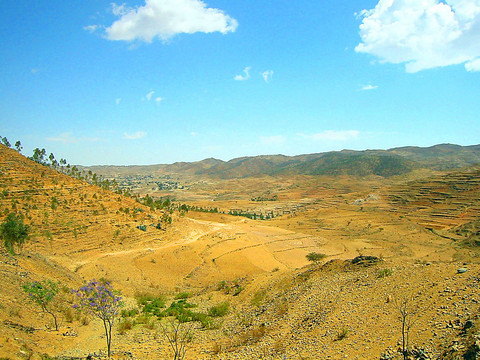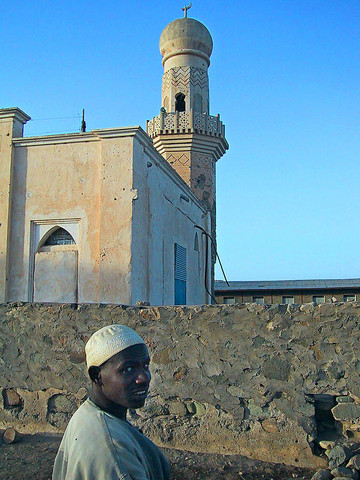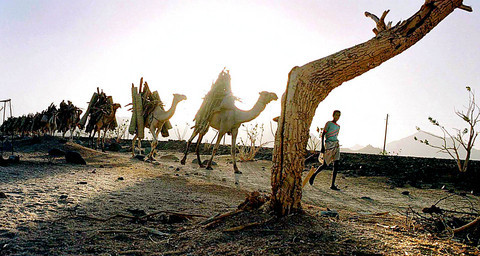Far too many of the strikingly good-looking young women of Asmara spend far too much time hanging around the Intercontinental Hotel, an overwrought, air-conditioned behemoth gobbling up a nowhere land between the Eritrean capital and its modest airport.
Here, they drink Coke and flirt with well-fed Italian UN soldiers, who, when not carousing, perform important duties like flexing and oiling their gym-pumped muscles by the hotel's pools.
That's pools: plural; in a country that has been suffering a five- year drought. This is a country overrun by well-cushioned foreign soldiery, 4 x 4-borne charities and NGOs. There are so many of these that sometimes theirs are the only cars on the dusty roads leading into and out of this extraordinary, and largely bypassed, city set high on the East African escarpment, high enough to set your heart racing if you rush about on your first day here.

I mention the girls, the soldiers and the Intercontinental because this unholy triptych representing contemporary Asmaran life prompted me to wonder if Eritrea has ever truly shaken off its colonial yoke. This was an Italian colony from 1898, when the first gover-nor was appointed, until 1941 when the British won control of this blisteringly hot Red Sea country. It later became an Ethiopian dependency, until after a 30 year war, Isiais Afewerki and his plastic sandal-wearing Eritrean Peoples Liberation Front won control of their own country.
For the next seven years, Eritrea basked in a reputation of being one of the most open and tolerant countries in Africa before a renewed clash with Ethiopia led to a presidential clampdown and a return to the country of all those UN troops spooning with the local girls, and NGOs by the baffling-acronym load.
Even so, Asmara itself is one of the most enchanting cities in Africa. I nearly typed "Italy," for this is a city largely created by the Italians over a very short period, and one in which the surprised visitor will find astonishingly similar to some cities in southern Italy and especially those built on the Pontine marshes by Mussolini in the 1930s.

PHOTO: AFP
Here you can eat all the pizza, pasta and ice cream your stomach could possibly desire, along with goat stew mopped up by injera, a sponge-like local pancake that may, or may not, be made with wheat.
Pavement cafes proffer cappuccino and espresso from vintage Italian coffee machines along with saccharine-sweet Arabic mint tea and refreshing Asmara (formerly Melotti) beer.
At sunset, the city sets out on a passegiatta, old men in double- breasted suits doffing Borsolino hats as they stroll along wide pavements under royal palms. They address foreigners in the Italian they learned as boys when what is now an utterly convincing Italian modernist city of the 1930s was a frenetic building site. Between 1935 and 1941, young Italian architects, and seasoned contractors working to a detailed urban plan, built somewhere between 400 and 500 fine new designs here: theatres, cinemas, hotels, churches, mosques, covered markets, city halls and, of course, a Casa del Fascio.

PHOTO: NY TIMES
The Casa del Fascio, shaped in the guise of a giant rendered-concrete "F' is now a part of the ministry of education. It broods, although in ice cream colors, so it can't be all that broody, at one end of Harnet, or Independence Avenue, the broad thoroughfare that characterizes and sets the pace for this would-be east African Rome and which has changed its name with each new regime, indigenous or imperial.
Mussolini's architects did a fine job. Whatever the outrages and injustices of his Fascist regime, Asmara is a thoroughly well planned and good-looking city. Here is one place in the world where surely anyone might allow themselves to give in to the sometimes cold and remotely intellectual charms of modernism.
Colored like confectionery, bejeweled with purple jacaranda and red bougainvillea, and set under high blue skies, how could anyone take offence and wish for more obviously romantic "colonial" or mud-hut architecture?
This Italian modernism is, in large part, Asmara's saving grace. Many of the city's buildings might be 70 years old, yet they remain incorrigbly Modern with a capital M. Asmara is not wealthy -- far from it -- and yet with its lively cafe culture and the natural grace and good manners of its people, it feels absolutely nothing like the desperate and downtrodden African cities we know all too well from TV news reports and the fund-raising efforts of well-meaning pop stars.
There is something, too, very special, despite the current clampdown on civil liberties, in the tolerant way Asmarinos share their lives. Here, Muslims, Catholics, Coptic and Greek Orthodox Christians and a handful of Jews live and work, cheek by jowl. They all have fine buildings to celebrate their God: a 1920s Gothic cathedral, which seems much older, on Harnet Avenue for the Catholics; the twin-towered and richly mosaiced Coptic Mariam cathedral; the handsome Al Qurafi al Rashidin mosque at the head of the central market buildings dating from 1937; the pretty Greek Orthodox church of St George; and a modestly scaled neoclassical synagogue.
Ancient and hard-held beliefs exist alongside the ice cream world of 1930s Italy. If you want to see a film, try the Impero Cinema on Martyrs Avenue. It's a beautifully restored art deco monument, robed in the rich colors of a Roman emperor's toga. If you want music and nightclubs, there is plenty of that and those. As for restaurants, you can eat Sudanese and Indian as well as Asmarino-Italian.
To watch the city go by, sit at one of the outside tables at the Bar Impero or Pasticeria Moderna on Harnet Avenue. In fact, you will be watching the world go by, too. The Asmarino diaspora has been on a biblical scale in recent years. My mid-morning coffee at the Moderna was paid for one morning by a man who had lived the past 30 years in Oslo and missed the snow, while, across from us, a young man, recently back from New York sported baseball cap, hood, saggy trousers, high-rise trainers, mobile phone and a big, pouting sneer as if downtown Asmara was somehow da South Bronx. This look, by the way, is thought eccentric: smiles, smart dress and good manners, even when there is so little money, are the norm rather than pouting, sneering, global brand culture.
How the city has been so well preserved might seem something of a miracle in a poor country especially after so many decades of war.
Fighting, though, has nearly always been in blisteringly hot rural areas, along desert borders, up and down the coast, and through devilish mountains passes. When the British took Asmara in 1941, they had bombed just one building. Mind you, the miserable sods stripped the city of much of its industrial machinery along with other essential parts of its infrastructure.
Although ordinary soldiers had been delighted, and amazed, to find a modern city, all ice cream, cinemas, Alfa-Romeos and gorgeous girls, their superiors considered Asmara too good for the locals. Their attitude was that the Italians had overspent and that it was only right to strip the city of modern machinery that could be used more profitably elsewhere by insatiably business-minded Brits.
To this day, many of the seemingly modern buildings in the city center lack running water, bathrooms and lavatories. While, at the edge of the city, the choking Medeber market is witness to huge numbers of Asmarinos recycling absolutely anything that can be turned into something useful: beds from lorry springs, chairs and tables from oil cans.
The city center is now, effectively, a listed zone where new buildings will only rarely be allowed. The Cultural Assets Rehabilitation Programme was set up in 1996 to record the city's architecture and to educate children, as well as business people and developers across the country, to look after their unparalleled urban heritage. Asmara may yet become a Unesco World Heritage Site. It fully deserves to be.
Perhaps the most unexpected restoration has been that of the enchanting Eritrean State Railway, which spirals in death-defying fashion down the escarpment from Asmara to meet the Red Sea at Massawa, another fascinating, although heavily war-damaged city, and one of the very hottest on earth.
The narrow-gauge railway, built by the Italians, has been rebuilt without outside help. National pride has seen to that. The necessary expertise lay in the hands and memories of long retired railwaymen, who have returned to bring the railway back to life.
There are, of course, no cheap flights to Eritrea. Tourism is in its infancy. There is little water, most of it unsafe to drink. The country is poor. It can be very hot indeed. Border disputes might break out at any time. Yet, where else will you find a city like Asmara? Unthreatening. Unexpected. Africa with a Neapolitan ice-cream scoop.

Behind a car repair business on a nondescript Thai street are the cherished pets of a rising TikTok animal influencer: two lions and a 200-kilogram lion-tiger hybrid called “Big George.” Lion ownership is legal in Thailand, and Tharnuwarht Plengkemratch is an enthusiastic advocate, posting updates on his feline companions to nearly three million followers. “They’re playful and affectionate, just like dogs or cats,” he said from inside their cage complex at his home in the northern city of Chiang Mai. Thailand’s captive lion population has exploded in recent years, with nearly 500 registered in zoos, breeding farms, petting cafes and homes. Experts warn the

No one saw it coming. Everyone — including the Chinese Nationalist Party (KMT) — expected at least some of the recall campaigns against 24 of its lawmakers and Hsinchu Mayor Ann Kao (高虹安) to succeed. Underground gamblers reportedly expected between five and eight lawmakers to lose their jobs. All of this analysis made sense, but contained a fatal flaw. The record of the recall campaigns, the collapse of the KMT-led recalls, and polling data all pointed to enthusiastic high turnout in support of the recall campaigns, and that those against the recalls were unenthusiastic and far less likely to vote. That

The unexpected collapse of the recall campaigns is being viewed through many lenses, most of them skewed and self-absorbed. The international media unsurprisingly focuses on what they perceive as the message that Taiwanese voters were sending in the failure of the mass recall, especially to China, the US and to friendly Western nations. This made some sense prior to early last month. One of the main arguments used by recall campaigners for recalling Chinese Nationalist Party (KMT) lawmakers was that they were too pro-China, and by extension not to be trusted with defending the nation. Also by extension, that argument could be

Aug. 4 to Aug. 10 When Coca-Cola finally pushed its way into Taiwan’s market in 1968, it allegedly vowed to wipe out its major domestic rival Hey Song within five years. But Hey Song, which began as a manual operation in a family cow shed in 1925, had proven its resilience, surviving numerous setbacks — including the loss of autonomy and nearly all its assets due to the Japanese colonial government’s wartime economic policy. By the 1960s, Hey Song had risen to the top of Taiwan’s beverage industry. This success was driven not only by president Chang Wen-chi’s